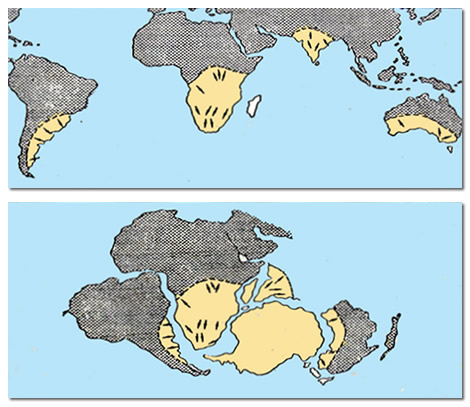(单词翻译:单击)
To be sure, Wegener made mistakes. He asserted that Greenland is drifting west by about a mile a year, which is clearly nonsense. (It's more like half an inch.) Above all, he could offer no convincing explanation for how the landmasses moved about. To believe in his theory you had to accept that massive continents somehow pushed through solid crust, like a plow through soil, without leaving any furrow in their wake. Nothing then known could plausibly explain what motored these massive movements.
魏格纳犯过错误,这点不假。他断言格陵兰岛在以每年大约1.6公里的速度向西漂移,这完全是胡说八道。(更可能是1厘米。)尤其是,他对大陆移动不能作出有说服力的解释。若要相信他的理论,你不得不承认大陆不知怎的像农犁耕地那样被推过坚实的地壳,而又没有在后面留下犁沟。根据当时的认识,无法解释是什么力驱动了这样大规模的移动。
It was Arthur Holmes, the English geologist who did so much to determine the age of the Earth, who suggested a possible way. Holmes was the first scientist to understand that radioactive warming could produce convection currents within the Earth. In theory these could be powerful enough to slide continents around on the surface. In his popular and influential textbook Principles of Physical Geology , first published in 1944, Holmes laid out a continental drift theory that was in its fundamentals the theory that prevails today. It was still a radical proposition for the time and widely criticized, particularly in the United States, where resistance to drift lasted longer than elsewhere. One reviewer there fretted, without any evident sense of irony, that Holmes presented his arguments so clearly and compellingly that students might actually come to believe them.
英国地质学家阿瑟·霍姆斯曾为确定地球的年龄作出了很大贡献。这次又是他提出了一种看法。霍姆斯是知道辐射热会在地球内部产生对流的第一位科学家。从理论上说,这种对流可能力量很大,能使大陆平面滑动。1944年,霍姆斯首次出版了一本深受欢迎、很有影响的教材《物理地质学原理》。在这本书里,他提出了大陆漂移学说。该理论的许多基本原则今天依然盛行。它在当时仍是一种很激进的见解,受到了许多人的批评,尤其在美国。美国人抵制漂移学说的时间比别处要长。有一位美国评论家发愁地说,霍姆斯论点清楚,令人信服,学生们慢慢会信以为真。他的话毫无挖苦之意。


